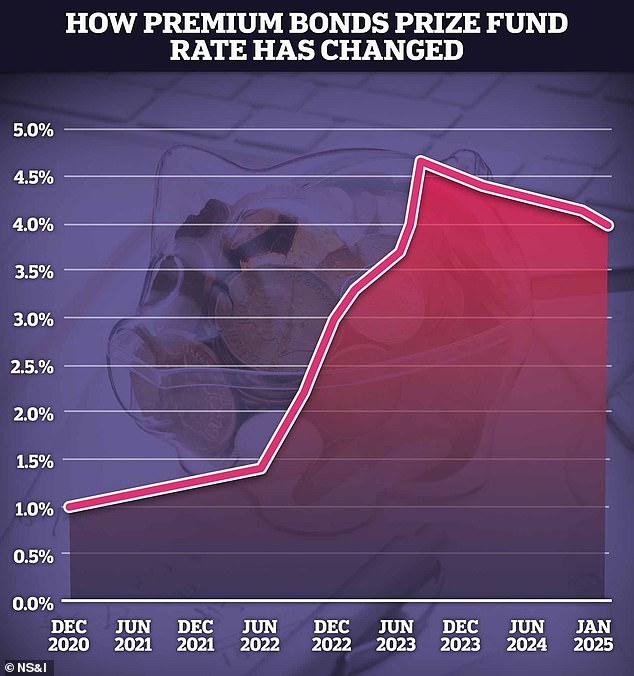National Savings & Investments has given its 22 million premium bondholders a Christmas gift they don’t want.
Yesterday it announced another cut to its prize rate.
It is already scheduled to fall from 4.4 percent to 4.15 percent in next week’s draw (December 2). But starting with the January draw it will fall to 4 percent, the lowest level since August 2023. That represents a total cut of 0.4 percentage points in just two months.
It is also cutting the rate on its easy-access Direct Savings and Income Bonds just five days before Christmas. These accounts are popular with retirees because they pay interest every month.
The Direct Saver rate will drop from 3.75 percent to 3.5 percent starting December 20. Until last week, I was paying 4 percent.
Cuts of the same size await holders of Income Bonds, where the rate falls to 3.44 percent as of December 20.
Andrew Westhead, retail director at NS&I, tells me the cuts follow those made by other suppliers.
These are coming in quickly from banks and building societies in response to two base rate cuts by the Bank of England from 5.25 per cent to 4.75 per cent since August.
These accounts are popular with retirees because they pay interest every month.
NS&I does not want to attract too much money by paying high rates for fear of missing the £9bn target the Government has asked it to raise in its current financial year which ends at the end of March next year. It has some room for maneuver (it could be £4bn above or below target), but without rate cuts it risks exceeding even its peak.
Further base rate cuts appear unlikely this year, meaning NS&I rates should not fall further either.
Last week we heard that the rise in the cost of living jumped to 2.3 per cent in the year to October, up from 1.7 per cent in September. This is above the Bank of England’s target inflation rate of 2 per cent.
As a result, experts now think a further cut in the base rate (originally expected at their December 19 meeting) is unlikely. Therefore, the next cut is not on the table until the Monetary Policy Committee meeting on February 6.
Of course, NS&I could cut rates before another drop in the base rate, but only if it finds it is awash with money. This could happen if other providers continue to cut their rates, making NS&I look generous again.
Despite the cuts, premium bonds are still a good option for some savers.
Their big advantage is that the prizes are tax-free, so they will appeal to savers who have used their £20,000 annual Isa allowance and their personal savings allowance, which gives basic rate taxpayers their first £1,000 in interest on non-Isa accounts with no tax payable. Higher rate payers get a subsidy of £500 a year, while top 45 per cent payers receive nothing.
Of course, they also appeal to those who like the idea of having a chance to win every month. The more you have, the better your chances of winning.

Below: The Premium Bond prize pool has been cut again. It will stand at 4% from January 2025 after being reduced to 4.15% last month.
Around two-thirds of premium bond holders (i.e. more than 14 million savers) have never won a prize, a freedom of information request by financial website AJ Bell reveals; and, unsurprisingly, those with smaller holdings are the most likely to be left out.
The average share of the 5.3 million winners in the 12 months to May this year was £23,037, with four in five winning more than once. The average holding of those who earned nothing during that time was £175.
The odds of winning in the December drawing are increasing from 21,000 to one to 22,000 to one. The odds for the January 2 drawing remain at 22,000 to one.
This month more than six million prizes were distributed. The figure is expected to fall to 5.726 million next month, but is expected to rise to 5.89 million in January. This is because NS&I has varied the size of the awards.
There will still be two £1 million jackpots left to win, but the number of other big prizes will decrease. The most affected are those of £100 and £50, which will fall by 71,071 between December and January.
At the same time, NS&I has increased the number of smaller £25 prizes from 1,498,592 in November to 1,509,458 in December and again to 1,815,854 in January. This is an additional £25,396 in prizes in January compared to December.
The increase comes even though it expects to pay out less in prizes: £431,938,050 in January compared to £435,686,300 in December (both down from £463,982,050 this month, when the prize fund stood at 4.4 percent).
Sy.morris@dailymail.co.uk
Some links in this article may be affiliate links. If you click on them, we may earn a small commission. That helps us fund This Is Money and keep it free to use. We do not write articles to promote products. We do not allow any commercial relationship to affect our editorial independence.

